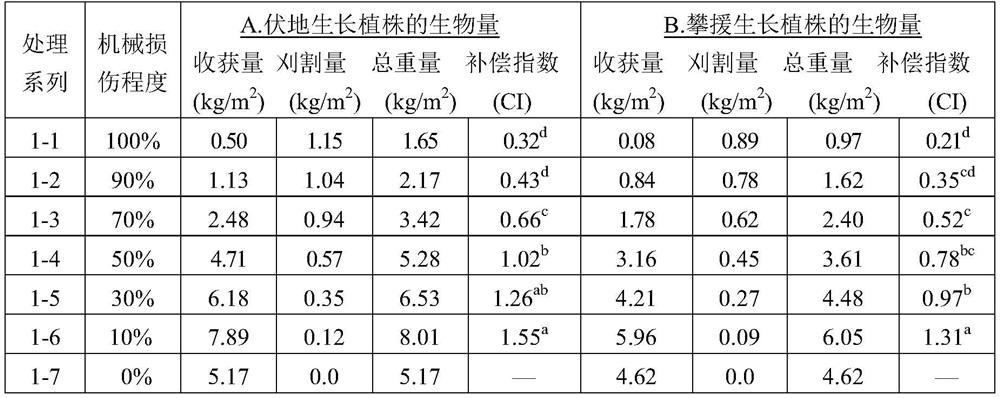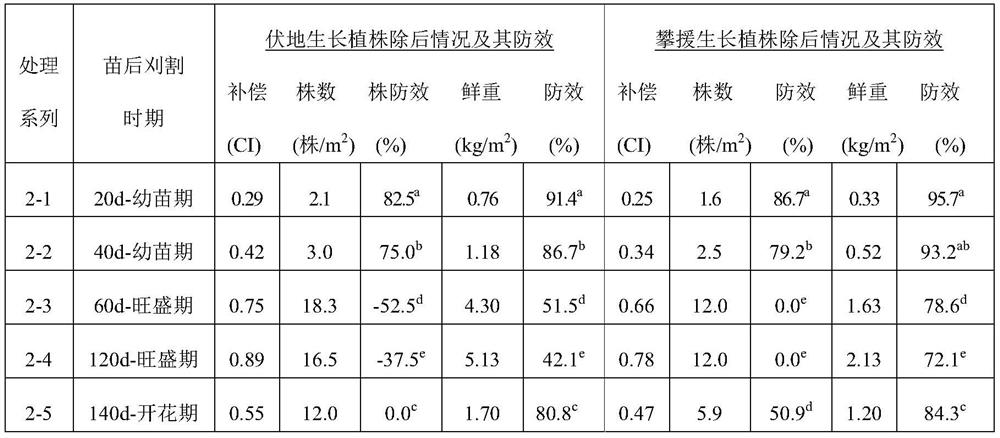A method of physical control using the invasive plant Mikania micrantha to compensate for the difference in response
A technology of invasive plants and physical control, applied in the field of plant protection of invasive plant prevention and control, can solve the problems such as difficult to determine the best time, strength, conditions and measures of physical control, achieve the reduction of plant cloning and reproduction ability, and improve the recovery growth ability , Improve the effect of the control effect
- Summary
- Abstract
- Description
- Claims
- Application Information
AI Technical Summary
Problems solved by technology
Method used
Image
Examples
Embodiment 1
[0053] Example 1 The difference in the compensation response of the invasive plant Mikania micrantha to different mechanical damages and its application to physical control
[0054] Test location and materials: The test was carried out in the wasteland on the outskirts of Ruili City, Dehong Prefecture, Yunnan Province (97°68′29″ east longitude, 23°86′75″ north latitude, 1206.3 meters above sea level). The landform type of the test area is hilly and mountainous, the soil is red soil, and the organic matter is 4.12g.kg -1 , total nitrogen 0.44g.kg -1 , total phosphorus 0.29g.kg -1 , total potassium 0.53g.kg -1 , pH 7.32. The annual average temperature is 21.2°C and the annual rainfall is 1355.2mm. This plot is a habitat where the invasive plant Mikania micrantha (Mikania micrantha H.B.K) occurs all the year round and is evenly distributed, with a coverage of 40-45%.
[0055]Test method: The main stem of the invasive plant Mikania micrantha grows to about 10cm (40 days after...
Embodiment 2
[0070] Example 2 Differences in the compensation level of the invasive plant Mikania micrantha in different growth stages and its application to physical control
[0071] Test materials: According to the results of the compensation response of Mikania micrantha to different degrees of mechanical damage according to Example 1, the present invention further tests the difference in the compensation response of the invasive plant at different growth stages and its physical control effect. The test materials were taken from Mikania micrantha H.B.K. in Example 1, Ruili City, Dehong Prefecture, Yunnan Province.
[0072] Test method: The cultivation test was carried out in a sunshine greenhouse under the condition of 24-28°C. The plots with uniform soil, good lighting and equal fertility were selected and organized into 56 plots of 3m×4m with an interval of 2.5m between plots. At the beginning of March, a single stem section of Mikania micrantha with leaf buds was selected as a clone ...
Embodiment 3
[0087] Example 3 The compensation difference between the invasive plant Mikania micrantha and native plants and its application to physical control
[0088]Test material: Compensation response difference of invasive plant Mikania micrantha and local plants The habitat is the same as in Example 1, and the investigation of crabgrass (Digitaria sanguinalis), Yunnan sugarcane grass (Erianthus rockii), weed grass (Arthraxon hispidus), wrinkled leaves Compensatory responses of 12 species of Mikania micrantha associated native plants including Setaria plicata, Triarrhenasacchariflora, Hedyotis auricularia and Artemisia carvifolia.
[0089] Test method: The research results of Example 1 and Example 2 show that the invasive plant Mikania micrantha has a higher plant compensation level than that of climbing growth under the condition of lying on the ground, and the same physical control method of eradication or mowing is adopted for the plants growing on the ground. Under the same condi...
PUM
 Login to View More
Login to View More Abstract
Description
Claims
Application Information
 Login to View More
Login to View More - R&D
- Intellectual Property
- Life Sciences
- Materials
- Tech Scout
- Unparalleled Data Quality
- Higher Quality Content
- 60% Fewer Hallucinations
Browse by: Latest US Patents, China's latest patents, Technical Efficacy Thesaurus, Application Domain, Technology Topic, Popular Technical Reports.
© 2025 PatSnap. All rights reserved.Legal|Privacy policy|Modern Slavery Act Transparency Statement|Sitemap|About US| Contact US: help@patsnap.com



